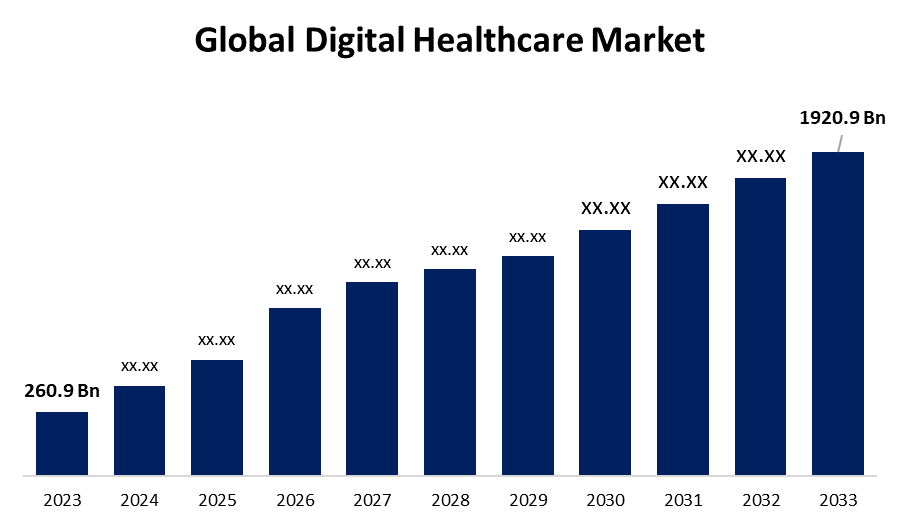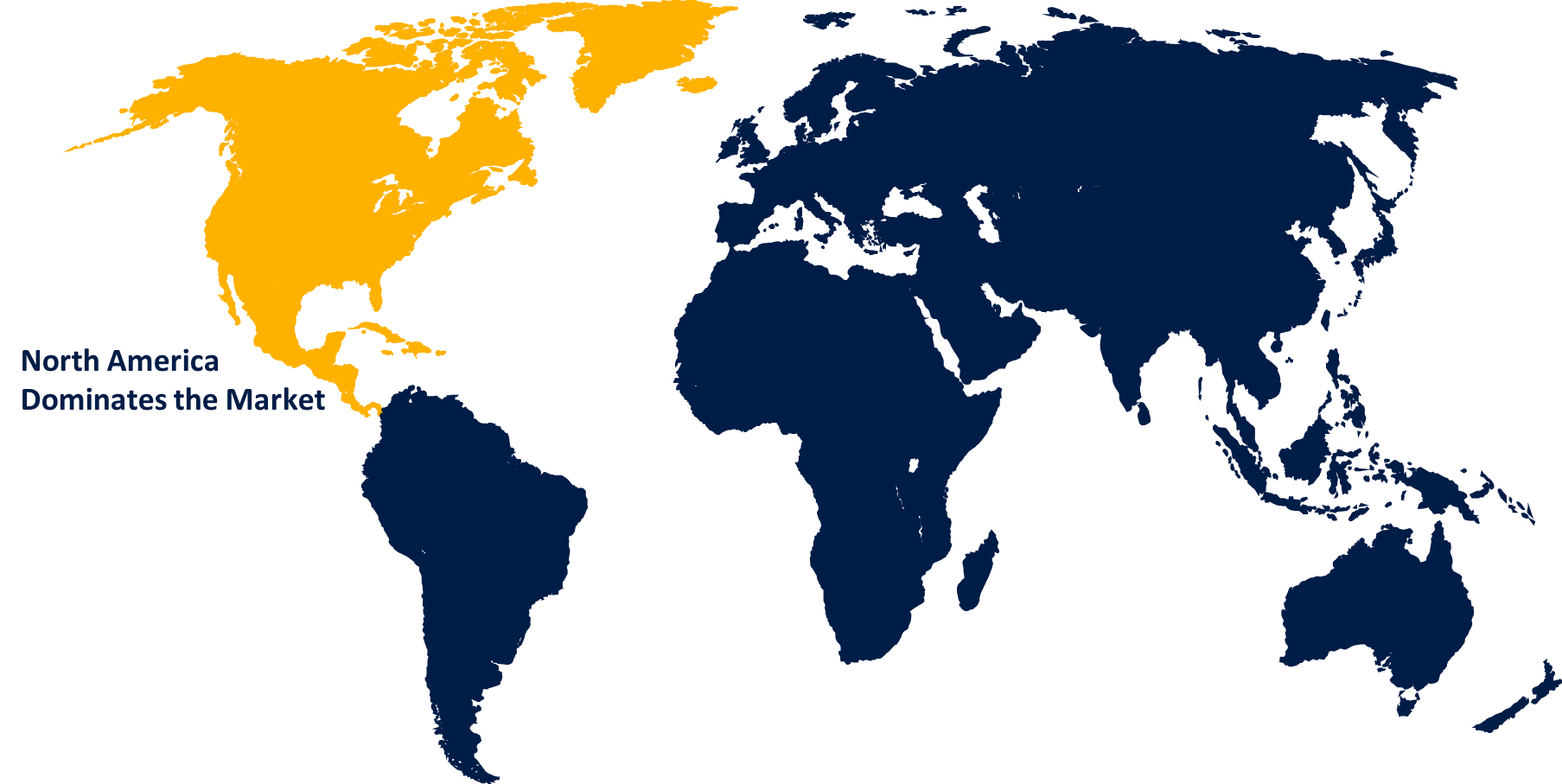Global Digital Healthcare Market Size, Share, and COVID-19 Impact Analysis, By Technology (Healthcare Analytics, mHealth, Telehealthcare, and Others), By Component (Hardware, Software, Services), By Application (Obesity, Cardiovascular, Diabetes, Respiratory Diseases, and Others), and By Region (North America, Europe, Asia-Pacific, Latin America, Middle East, and Africa), Analysis and Forecast 2023 - 2033.
Industry: HealthcareGlobal Digital Healthcare Market Insights Forecasts to 2033
- The Global Digital Healthcare Market Size was Valued at USD 260.9 Billion in 2023
- The Market Size is Growing at a CAGR of 22.10% from 2023 to 2033
- The Worldwide Digital Healthcare Market Size is Expected to Reach USD 1920.9 Billion by 2033
- Aisa Pacific is Expected to Grow the fastest during the forecast period.

Get more details on this report -
The Global Digital Healthcare Market Size is Anticipated to Exceed USD 1920.9 Billion by 2033, Growing at a CAGR of 22.20% from 2023 to 2033.
Market Overview
Digital healthcare uses computing systems, networking, software, and sensors to provide health care and other applications. It includes a wide range of technologies such as mobile health apps, wearable devices, telemedicine services, electronic health records (EHRs), and various health information systems. Digital health technologies empower consumers by enabling them to make informed health decisions and offering new options for prevention, early diagnosis of life-threatening diseases, and managing chronic conditions outside traditional healthcare settings. Providers and stakeholders use these technologies to minimize inefficiencies, improve access, lower costs, improve treatment quality, and tailor medicine for their patients. The digital healthcare market includes medical services and technologies connected to digital healthcare operations. The market includes immunosuppressant medications, medical devices, and other products used for long-term care of transplant recipients to assist prevent organ rejection. In March 2024, UNICEF India, the International Institute of Health Management Research (IIHMR) Delhi, and the Indian Institute of Technology Bombay (IIT Bombay) jointly launched a comprehensive health course that empowers healthcare professionals, including doctors, nurses, pharmacists, healthcare administrators, and allied health professionals, with the skills to assist the healthcare sector's digital transformation.
Report Coverage
This research report categorizes the market for the digital healthcare market based on various segments and regions forecasts revenue growth and analyzes trends in each submarket. The report analyses the key growth drivers, opportunities, and challenges influencing the digital healthcare market. Recent market developments and competitive strategies such as expansion, product launch, and development, partnership, merger, and acquisition have been included to draw the competitive landscape in the market. The report strategically identifies and profiles the key market players and analyses their core competencies in each sub-segment of the digital healthcare market.
Global Digital Healthcare Market Report Coverage
| Report Coverage | Details |
|---|---|
| Base Year: | 2023 |
| Market Size in 2023: | USD 260.9 Billion |
| Forecast Period: | 2023 - 2033 |
| Forecast Period CAGR 2023 - 2033 : | 22.10% |
| 2033 Value Projection: | USD 1920.9 Billion |
| Historical Data for: | 2019-2022 |
| No. of Pages: | 280 |
| Tables, Charts & Figures: | 110 |
| Segments covered: | By Technology, By Component, By Application |
| Companies covered:: | Koninklijke Philips N.V., Abbott, Siemens Healthineers AG, Medtronic, General Electric Company, Dexcom Inc., Johnson & Johnson, Fitbit, Inc, Masimo, AirStrip Technologies, Telefonica S.A., IBM corporation, CISCO System, Inc, Apple Inc., and Others |
| Pitfalls & Challenges: | Covid 19 Impact Challanges, Future, Growth and Analysis |
Get more details on this report -
Driving Factors
The digital health market is driven by technological advancements such as AI and telemedicine, increased healthcare accessibility, cost pressures, an aging population's needs, consumer demand for health management tools, supportive regulations, and data analytics for personalized medicine. The impact of the COVID-19 pandemic on telehealth adoption, and significant investment in digital health innovations. The adoption of digital health devices is also increasing in emerging markets due to the advent of low-cost gadgets and the ongoing expansion of high-speed mobile networks. The widespread use of smartphones, tablets, and other mobile platforms has become a major driver in the digital health market. This technology convergence helps individuals monitor their health, access medical consultations online, and collect real-time health data, eventually creating a more proactive approach to healthcare.
Restraining Factors
The adoption and growth of digital healthcare technologies face challenges including regulatory complexities, concerns about data privacy and security, integration difficulties with existing healthcare systems, disparities in technology access, resistance to change among healthcare professionals and patients, and a need for more robust evidence of long-term effectiveness. The cost of many digital health technologies is very high, making it difficult for particularly small and medium-sized healthcare organizations to implement them.
Market Segmentation
The digital healthcare market share is classified into technology, component, and application.
- The telehealthcare segment is anticipated to grow at the fastest CAGR growth through the forecast period.
Based on the technology, the digital healthcare market is classified into healthcare analytics, mHealth, telehealthcare, and others. Among these, the telehealthcare segment is anticipated to grow at the fastest CAGR growth through the forecast period. The telehealthcare growth rate can be attributed to improved internet connectivity, increased smartphone penetration, advanced technology readiness, a growing shortage of healthcare providers, rising medical costs, widespread availability of telehealth applications, and increased adoption of these technologies by patients and physicians. The ongoing evolution of telehealth applications, as well as quick technology innovations, help to drive segment growth.
- The service segment is estimated to hold the highest market revenue share through the projected period.
Based on the components, the digital healthcare market is divided into hardware, software, and services. Among these, the service segment is estimated to hold the highest market revenue share through the projected period. The service segment specializes in building, optimizing, and managing digital systems that ensure smooth operation, data security, regulatory compliance, and enhanced patient outcomes via advanced analytics and telemedicine capabilities. As healthcare providers continue to embrace digital transformation, demand for these services is likely to fuel substantial market development.
- The diabetes segment is anticipated to grow at the fastest CAGR growth through the forecast period.
Based on the application, the digital healthcare market is categorized into obesity, cardiovascular, diabetes, respiratory diseases, and others. Among these, the diabetes segment is anticipated to grow at the fastest CAGR growth through the forecast period. Digital health technologies provide novel solutions to meet the needs of diabetics. Patients can actively manage their diabetes using digital health technologies such as smartphone applications for glucose monitoring and wearable gadgets that track physical activity and provide real-time health data. Furthermore, these technologies enable remote patient monitoring, allowing healthcare providers to obtain timely data, make informed judgments, and deliver timely interventions, resulting in more successful diabetes control.
Regional Segment Analysis of the Digital Healthcare Market
- North America (U.S., Canada, Mexico)
- Europe (Germany, France, U.K., Italy, Spain, Rest of Europe)
- Asia-Pacific (China, Japan, India, Rest of APAC)
- South America (Brazil and the Rest of South America)
- The Middle East and Africa (UAE, South Africa, Rest of MEA)
North America is anticipated to hold the largest share of the digital healthcare market over the predicted timeframe.

Get more details on this report -
North America is anticipated to hold the largest share of the digital healthcare market over the predicted timeframe. North America's dominance can be attributed to reasons such as sufficient reimbursement rules in the United States, high per capita expenditure on sophisticated technology, top healthcare IT enterprises, and increased demand for healthcare technologies in the region. Factors such as rising chronic disease rates, and an aging population accelerated the region's adoption of digital health technologies.
Asia Pacific is expected to grow at the fastest CAGR growth of the digital healthcare market during the forecast period. Asia Pacific is predicted to grow due to technological and medical developments, as well as shifting regulatory rules in the region. Furthermore, initiatives established by developing-country governments are promoting digital healthcare solutions in the region. According to the Ministry of Health and Family Welfare, the National Health Authority (NHA) announced in July 2022 the expansion of the digital health ecosystem built under its flagship scheme, the Ayushman Bharat Digital Mission (ABDM), with the successful integration of 52 digital health applications in India. The Ministry of Health in China has defined an action plan for the usage of services related to e-health across the country encompassing broad areas of medical services, insurance plans, and with a large focus on the adoption of electronic record, systems to allow data sharing across the national healthcare system.
Competitive Analysis:
The report offers the appropriate analysis of the key organizations/companies involved within the digital healthcare market along with a comparative evaluation primarily based on their product offering, business overviews, geographic presence, enterprise strategies, segment market share, and SWOT analysis. The report also provides an elaborative analysis focusing on the current news and developments of the companies, which includes product development, innovations, joint ventures, partnerships, mergers & acquisitions, strategic alliances, and others. This allows for the evaluation of the overall competition within the market.
List of Key Companies
- Koninklijke Philips N.V.
- Abbott
- Siemens Healthineers AG
- Medtronic
- General Electric Company
- Dexcom Inc.
- Johnson & Johnson
- Fitbit, Inc
- Masimo
- AirStrip Technologies
- Telefonica S.A.
- IBM corporation
- CISCO System, Inc
- Apple Inc.
- Others
Key Target Audience
- Market Players
- Investors
- End-users
- Government Authorities
- Consulting And Research Firm
- Venture capitalists
- Value-added resellers (VARs)
Recent Developments
- In June 2024, WHO/Europe is preparing to launch its inaugural Strategic Partners' Initiative for Data and Digital Health (SPI-DDH) in Copenhagen, Denmark. This newly founded project will begin its collaborative work to identify and fix gaps in data and digital health ecosystems, helping to build safe, economical, and person-centered health systems in the WHO European Region.
- In January 2024, Eli Lilly & Company unveiled LillyDirect, a new digital healthcare experience for people in the United States living with obesity, migraines, and diabetes. LillyDirect provides illness management options, such as access to independent healthcare providers, personalized support, and direct home delivery of chosen Lilly medicines via third-party pharmacy dispensing services.
Market Segment
This study forecasts revenue at global, regional, and country levels from 2023 to 2033. Spherical Insights has segmented the digital healthcare market based on the below-mentioned segments:
Global Digital Healthcare Market, By Technology
- Healthcare Analytics
- mHealth
- Telehealthcare
- Others
Global Digital Healthcare Market By Component
- Hardware
- Software
- Services
Global Digital Healthcare Market, By Application
- Obesity
- Cardiovascular
- Diabetes
- Respiratory Diseases
- Others
Global Digital Healthcare Market, By Regional Analysis
- North America
- US
- Canada
- Mexico
- Europe
- Germany
- UK
- France
- Italy
- Spain
- Russia
- Rest of Europe
- Asia Pacific
- China
- Japan
- India
- South Korea
- Australia
- Rest of Asia Pacific
- South America
- Brazil
- Argentina
- Rest of South America
- Middle East & Africa
- UAE
- Saudi Arabia
- Qatar
- South Africa
- Rest of the Middle East & Africa
Frequently Asked Questions (FAQ)
-
1. What is the CAGR of the digital healthcare market over the forecast period?The digital healthcare market is projected to expand at a CAGR of 22.10% during the forecast period.
-
2. What is the market size of the digital healthcare market?The Global Digital Healthcare Market Size is Expected to Grow from USD 260.9 Billion in 2023 to USD 1920.9 Billion by 2033, at a CAGR of 22.10% during the forecast period 2023-2033.
-
3. Which region holds the largest share of the digital healthcare market?North America is anticipated to hold the largest share of the digital healthcare market over the predicted timeframe.
Need help to buy this report?